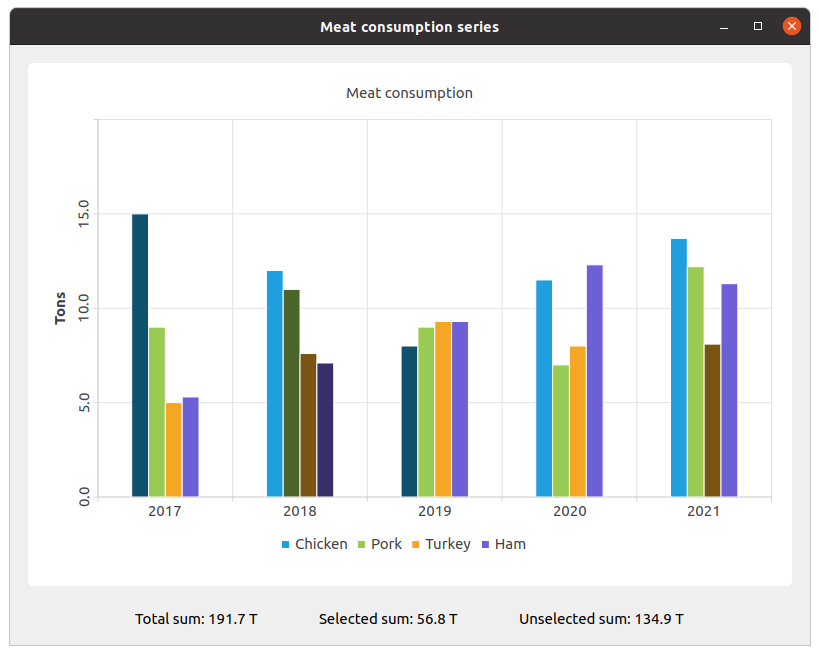Warning
This section contains snippets that were automatically translated from C++ to Python and may contain errors.
SelectedBar Example#
The example shows how to use a selection feature for the bar chart.
The example shows changing the color and state of bars using the selection feature.
Running the Example#
To run the example from Qt Creator , open the Welcome mode and select the example from Examples. For more information, visit Building and Running an Example .
Using setBarSelected()#
We create the sets and fill them with the data. Then we create a series and append data to it.
setChicken = Utilities::createChickenSet() setPork = Utilities::createPorkSet() setTurkey = Utilities::createTurkeySet() setHam = Utilities::createHamSet() totalSum = setChicken.sum() + setPork.sum() + setTurkey.sum() + setHam.sum() QList<QBarSet *> setList = QList<QBarSet *>{setChicken, setPork, setTurkey, setHam} series = QBarSeries() series.append(setList)
We create the chart and add series to it. Also, we add a title to the chart, set animation for the chart, and align the legend.
chart = QChart() chart.addSeries(series) chart.setTitle(QCoreApplication.tr("Meat consumption")) chart.setAnimationOptions(QChart.SeriesAnimations) chart.legend().setVisible(True) chart.legend().setAlignment(Qt.AlignBottom)
Here we set the color for the selected bars.
for barSet in series.barSets(): barSet.setSelectedColor(barSet.brush().color().darker())
Next step is adding axes: QBarCategoryAxis for years of measurements and QValueAxis for values range.
categories = Utilities::createYearCategories() axisX = QBarCategoryAxis() axisX.setCategories(categories) chart.addAxis(axisX, Qt.AlignBottom) series.attachAxis(axisX) axisY = QValueAxis() axisY.setRange(0, 20) axisY.setTitleText(QCoreApplication.tr("Tons")) axisY.setLabelsAngle(-90) axisY.setTitleVisible(True) chart.addAxis(axisY, Qt.AlignLeft) series.attachAxis(axisY)
Then we add the chart view to put the chart in.
chartView = QChartView(chart) chartView.setRenderHint(QPainter.Antialiasing)
Here we create a widget for labels of values of selected and unselected bars.
labelWidget = QWidget(mainWindow) labelLayout = QHBoxLayout(labelWidget) labelLayout.setAlignment(Qt.AlignCenter) totalSumLabel = QLabel(QCoreApplication.tr("Total sum: %1 T").arg(totalSum)) labelLayout.addWidget(totalSumLabel) totalSumLabel.setContentsMargins(0, 0, 54, 0) selectedSumLabel = QLabel(QCoreApplication.tr("Selected sum: 0 T")) labelLayout.addWidget(selectedSumLabel) unselectedSumLabel = QLabel(QCoreApplication.tr("Unselected sum: %1 T").arg(totalSum)) labelLayout.addWidget(unselectedSumLabel) unselectedSumLabel.setContentsMargins(54, 0, 0, 0)
We connect selecting of a specific bar with labels of values using a lambda. set->toggleSelection({index}) sets the bar selected.
series.clicked.connect(series, [=](int index, QBarSet *set) { set.toggleSelection({index}) selectedSum = 0. for i in range(0, setList.size()): selectedIndices = setList.at(i).selectedBars() for k in range(0, selectedIndices.size()): selectedSum += setList.at(i).at(selectedIndices.at(k)) selectedSumLabel.setText(QCoreApplication.tr("Selected sum: %1 T").arg(selectedSum)) # Because of rounding errors, selectedSum can result in being bigger than total sum unselectedSum = totalSum - selectedSum < 0 if 0. else totalSum - selectedSum unselectedSumLabel.setText( QCoreApplication.tr("Unselected sum: %1 T") .arg(unselectedSum) ) })
Finally, we create the main widget and add other layouts to it and run the application.
mainWidget = QWidget(mainWindow) mainLayout = QVBoxLayout(mainWidget) mainLayout.addWidget(chartView) mainLayout.addWidget(labelWidget) mainWindow.setCentralWidget(mainWidget) mainWindow.resize(800, 600) mainWindow.show() return a.exec()
